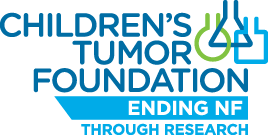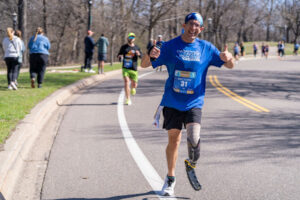 Living with neurofibromatosis type 1 (NF1), Matthew Haas has found strength in every step, setting his pace toward a mission of endurance and hope. From surgeries and living with a plexiform tumor to embracing life as an amputee, Matthew shares how running fuels his purpose and helps raise awareness for the NF community. In this candid Q&A, he talks about his journey, training challenges, and what motivates him to keep going.
Living with neurofibromatosis type 1 (NF1), Matthew Haas has found strength in every step, setting his pace toward a mission of endurance and hope. From surgeries and living with a plexiform tumor to embracing life as an amputee, Matthew shares how running fuels his purpose and helps raise awareness for the NF community. In this candid Q&A, he talks about his journey, training challenges, and what motivates him to keep going.
Can you share your NF journey with us — from diagnosis to where you are today?
I was diagnosed as a baby with café-au-lait spots and a plexiform tumor in my left foot. I had multiple surgeries growing up, mostly debulking, but the tumor always came back before the cast even came off. I also had a couple of orthotic surgeries for overpronation—one with a pin in my foot, another using bone from my hip.
Eventually, I lived with it as best I could. In college, I joined a clinical trial for selumetinib (later Koselugo) at Mayo. It shrank the tumor, but the side effects were too much, so I dropped out. That’s when a doctor first mentioned amputation, though I could wait until adulthood. Looking back, I wish I’d done it then. It’s been that positive.
After grad school, I moved to Germany for a postdoc. In 2017, flying home for the holidays, I fell and broke my leg because of the tumor; it had gotten so bad 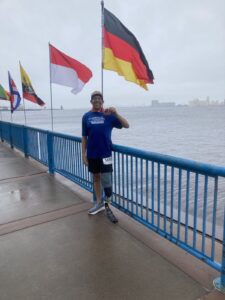 I could barely find shoes that fit. I was stranded overnight in Amsterdam and went straight to urgent care when I landed. That’s where I met the surgeon who would amputate my foot. Funny enough, we went to the same university, he graduated just four years ahead of me.
I could barely find shoes that fit. I was stranded overnight in Amsterdam and went straight to urgent care when I landed. That’s where I met the surgeon who would amputate my foot. Funny enough, we went to the same university, he graduated just four years ahead of me.
I was almost giddy going into surgery, like a kid on Christmas Eve. Having control over the decision and choosing my surgeon made a big difference. Honestly, I can’t think of any downside to having one foot. Thanks to modern prosthetics, I often forget that I’m an amputee.
Before the amputation, the tumor drew a lot of unwanted attention. Now, people still look, but it feels different, more curiosity than discomfort. I think it’s because people understand limb loss more than NF. And it’s easier to talk about now than ever before.
What inspired you to start running and join the NF Endurance team?
I always wanted to run, but the tumor in my foot made it impossible. When I lived in Germany, I’d visit Berlin and envy the runners in the Tiergarten. That dream stuck with me.
I’ve been lucky to have amazing support from my prosthetist, Todd Westlake, who got me moving early on. In 2021, he took me to the Endeavor Games in
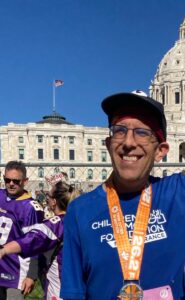
“One piece of advice that’s stuck with me—both in running and in life—is to just keep moving.”
Oklahoma and introduced me to the Challenged Athletes Foundation. They provided the blade for my running prosthesis, and Todd built the socket. I got the blade in early 2022 and started using it right away, though I never imagined running a marathon.
I ran the Get in Gear 5K a few months later, then a few more 5Ks that year before catching the distance bug. The amputee community has been huge too. Wiggle Your Toes, a Twin Cities nonprofit, runs winter mobility clinics that keep me motivated, even on cold Sunday mornings. Coach Adam designs great programs to help us improve and fix imbalances (which all runners have, amputees or not).
As a proud Minnesotan, I wanted the Twin Cities Marathon to be my first. But when I learned I’d be running Berlin with CTF in 2025, I moved up Twin Cities to 2024. Running your first marathon is intimidating, and sleeping in my own bed the night before seemed like a good idea.
Distance runners always chase new goals—world majors, marathons in every state, or every place you’ve lived. I didn’t live in Berlin, but I spent enough time there to feel at home. The “local” marathon near where I lived (Quedlinburg) has a brutal course—up and down the Brocken with over 1,100 meters of elevation—so Berlin’s fast, flat course feels like a better choice for now.
Once I decided to run Berlin, I researched charity entries and was excited to find CTF listed. I reached out to Lydia (CTF’s NFE Director) right away, and the rest is history.
What’s one piece of training advice that really stuck with you — and why?
One piece of advice that’s stuck with me, both in running and in life, is to just keep moving. Don’t stop. Keep putting one foot in front of the other until you reach the finish. Nothing in the marathon registration says you can’t walk part of it.
Of course, you don’t want to push to the point of injury, but you’re more capable than you think. Another bit of advice I like: go for a run whether you feel like it or not. Your feelings don’t determine your ability. And if you’re a mile in and still not feeling it? You can always turn around and go home.
What has been your biggest challenge training for the Berlin Marathon, and how did you overcome it?
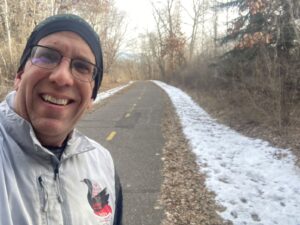 They say running a marathon isn’t the hard part, it’s the training. My Berlin training is just getting started, but I can look back on what I went through for the 2024 Twin Cities Marathon.
They say running a marathon isn’t the hard part, it’s the training. My Berlin training is just getting started, but I can look back on what I went through for the 2024 Twin Cities Marathon.
I trained in all kinds of weather—heat, humidity, rain. I dreaded some runs, but was always glad I did them. One of the hardest moments came 16 miles into an 18-mile run, when I tripped over myself and hit the pavement. A few other runners helped me up, but I had to walk two miles back to my car with a bruised and bloody face. It shook my confidence and made me question if I could really do it.
A few weeks later, I ran a supported 20-miler without falling. I did have to stop halfway to drain sweat from my socket, and drying my leg was tough in the rain. I worried about my time (even though it didn’t really matter). But on marathon day, the weather was perfect, and I made it through the whole race without needing to stop.
What does it mean to you to race (and fundraise) with the NF Endurance team?
It means a lot to have found the NF Endurance team. Before running, I was into cycling, and I remember seeing riders with “NF” on their jerseys. I don’t know if they were with CTF, but just seeing it made me feel less alone, even without talking to them.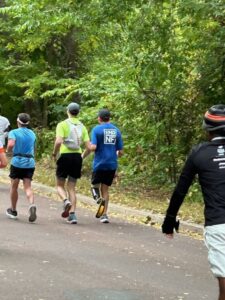
Now, when I run with “END NF” on my back, I sometimes wonder if I give someone else that same feeling. I’ve also had people ask me what NF is, which I appreciate because it gives me the chance to share.
It’s rare to meet others with NF in daily life, so connecting with teammates through Zoom has been meaningful. Fundraising feels personal for me, there’s a natural link between my story and this cause. There are so many worthy causes out there, and it’s not always easy to convince people why yours should stand out. So when someone is moved by my story or my teammates’ and chooses to give, it’s a real honor.
What would you say to someone newly diagnosed with NF who is struggling to find hope?
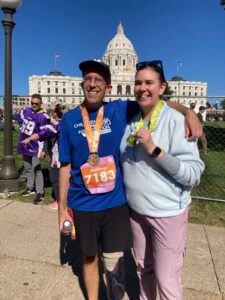
Matthew and his sister
It’s a tough road, no doubt, but you don’t have to go through it alone. There are supportive people out there, and you don’t need to suffer in silence.
I know how tempting it can be to chase unproven treatments when you’re desperate for relief. But try to resist the snake oil. There are real doctors and researchers doing good work, and every donation to CTF helps move us closer to real therapies—Koselugo and Gomekli are proof of that.
If you’re eligible, consider joining a clinical trial. If cutaneous tumors bother you, ask about getting them removed. It’s not a cure, but it can help.
And if you have a plexiform tumor in your foot like I did, seriously think about amputation. For me, it was a night-and-day difference in how I view myself and live my life.
Is there anything else you'd like to share — about training, running, life with NF, or what keeps you motivated?
Now that I have a niece and nephew, it’s important to me to model a healthy lifestyle. Healthy habits build on each other. Since I started running, I’ve 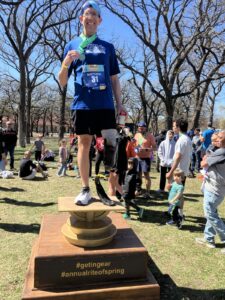 improved my diet, cut back on alcohol (though I still enjoy a good craft or German beer), and built a routine of running, swimming, and strength training.
improved my diet, cut back on alcohol (though I still enjoy a good craft or German beer), and built a routine of running, swimming, and strength training.
I like to say I’m like a cat, I really like my routine. Seeing progress in my race times and how I feel day to day keeps me going. I eat better, sleep better, and my mood is more stable. I still deal with anxiety, but it’s much more manageable.
One other piece of advice I’d share: if you want to see your friends, invite them for a run or a walk. Socializing doesn’t always have to revolve around drinks, and you’d be surprised how many people say yes.
Outside of training, I spend time with family and friends and volunteer in my community, mostly with the Germanic-American Institute and Twin Cities in Motion events I’m not racing in.
